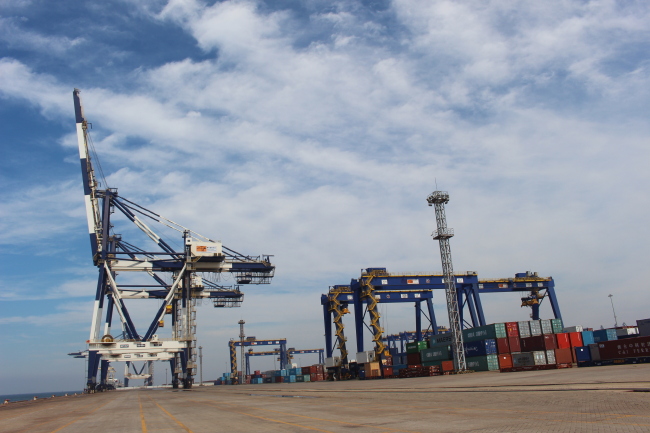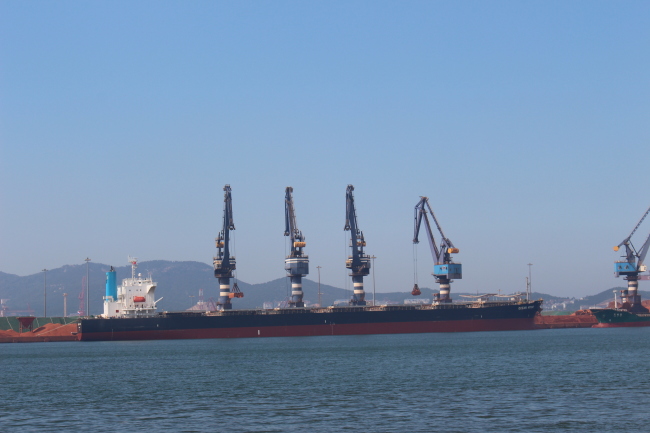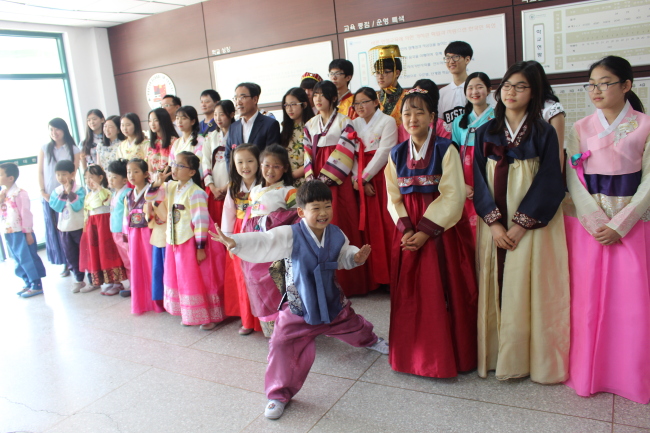“Choose Yantai and head for the future,” reads a Korean billboard in Yantai, Shandong province, facing the Korean Peninsula across the Yellow Sea.
The phrase represents the Chinese government’s resolve to foster the city into an economic hub to support growing economic relations with Korea.
The relationship between South Korea and China relations has had its ups and downs, most recently with the two neighbors failing to see eye-to-eye on the deployment in Korea of the US Terminal High Altitude Area Defense system.
 |
Containers are piled next to a crane at a Yantai port. (Yoon Min-sik/The Korea Herald) |
But the coastal city of Yantai has always stressed the importance of integrating China’s “One Belt, One Road” with Korea’s resolve to expand cooperation with neighboring countries.
The “One Belt, One Road” initiative is a development strategy envisioned by the Chinese government that focuses on China’s connectivity and cooperation with neighboring countries.
A visiting group of international journalists in June were introduced to the China-South Korea Yantai Industrial Park, a joint development project between the two countries.
“The Yantai industrial park, set up under the China-South Korea FTA, represents a crucial opportunity to strengthen cooperation with Korea and seek mutual development through it,” said Yantai Mayor Zhang Yongxia.
“Yantai will create an industrial environment that follows the international standards to attract investment. I believe the industrial park is the best choice for Korean firms.”
She said that Korea is the city’s biggest partner in terms of foreign investment and trade, and stressed that the cooperation was not only in industrial sectors, but also in culture and tourism.
“Korea has a substantially large capacity in cultural content, which is welcomed in China. I hope Yantai will become a foothold for Korean firms in such industry seeking to enter Chinese market.”
The industrial park, while still in its initial stages of development, is expected to attract 117.3 billion yuan ($1.76 billion) worth of investment in the next 10 years, officials said. It is also to receive 24 different benefits from the government in nine sectors such as trade, investment, finance and transportation.
 |
A freighter is seen at a port in Yantai. (Yoon Min-sik/The Korea Herald) |
The economic cooperation between Korea and Yantai is rooted in robust investment, which appears to have stepped up to a higher level after the Korea-China FTA took effect last year. According to a recent report by China Daily, the contractual investment from Korea on Yantai was estimated at $160 million from January to May, marking a 65 percent on-year hike.
Korean firms have invested a total of $5.56 billion in the city, with 3,651 projects having been launched as of the end of May.
Located just 448 kilometers from Incheon, which makes it closer to Korea than Beijing, its 7 million residents contribute roughly 644.6 billion yuan ($96.8 billion) in gross domestic products. The trade volume between Yantai and Korea is estimated to be around $11 billion, accounting for about one-third of Shandong province’s total trade volume with the country.
Roughly four out of 10 companies based in Yantai export their products to Korea.
It also houses key Korean corporations including Doosan Infracore, LG Electronics, Hyundai Motor, Hanwha Group and Posco, with roughly 15,000 Koreans residing there.
In a bid to assist Korean firms in settling down, Yantai operates the Yantai Korean School for children of employees working at such companies. Its curriculum is largely based on the Korean public education system to help children adapt better to Korean universities, while it also has localized programs such as Chinese language courses.
 |
Children at Yantai Korean School pose for a photo during visit by international group of journalists. (Yoon Min-sik/The Korea Herald) |
Projects that received joint investment from the two countries include Luye Bobath Rehabilitation Hospital, the first domestic rehabilitation hospital in China, commenced operation in June.
While 13 ships and 17 air freight flights are operated each week to major Korean destinations from Yantai, the city looks to increase connectivity by pushing for a project that would operate a ferry carrying a freight train directly Korea.
“The ferry train operated between Yantai and Dalian (in Liaoning province) managed to shorten the distance of transportation and costs by a large margin,” said Liu Jun, the general manager of the Sino Rail Bohai Train Ferry Co, Ltd. “I hope that Korea will pursue the train ferry between Yantai and the port of Pyeongtaek (Gyeonggi Province) in the near future.”
By Yoon Min-sik
(
minsikyoon@heraldcorp.com)
caption: credit: Yoon Min-sik/ The Korea Herald
A freighter is seen at a port in Yantai.
Containers are piled next to a crane at a Yantai port.
Children at Yantai Korean School pose for a photo during visit by international group of journalists.






![[Herald Interview] 'Trump will use tariffs as first line of defense for American manufacturing'](http://res.heraldm.com/phpwas/restmb_idxmake.php?idx=644&simg=/content/image/2024/11/26/20241126050017_0.jpg)

![[Health and care] Getting cancer young: Why cancer isn’t just an older person’s battle](http://res.heraldm.com/phpwas/restmb_idxmake.php?idx=644&simg=/content/image/2024/11/26/20241126050043_0.jpg)

